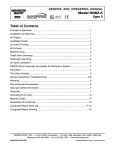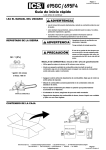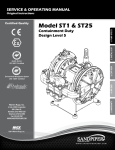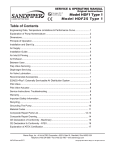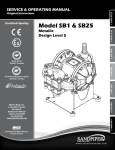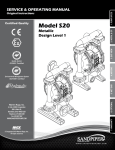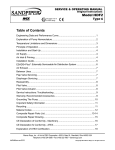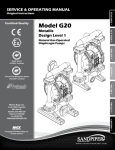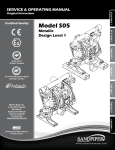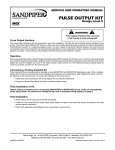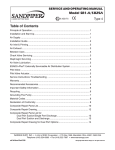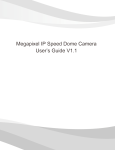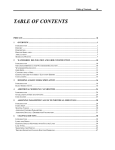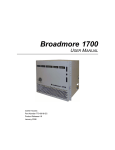Download PDF
Transcript
SERVICE & OPERATING MANUAL Original Instructions See pages 18 & 19 IIfor2GD T5 ATEX ratings Model HDB2 Type 3 Table of Contents Engineering Data and Performance Curve............................................................ 1 Explanation of Pump Nomenclature and Temperature Limitations......................... 2 Dimensions............................................................................................................. 3 Principle of Operation............................................................................................. 4 Installation and Start-Up......................................................................................... 4 Air Supply............................................................................................................... 4 Installation Guide.................................................................................................... 5 Air Inlet & Priming................................................................................................... 6 Air Exhaust............................................................................................................. 6 Between Uses........................................................................................................ 6 Check Valve Servicing............................................................................................ 6 Diaphragm Servicing.............................................................................................. 6 Air Valve Lubrication............................................................................................... 7 ESADS+Plus®: Externally Serviceable Air Distribution System................................. 7 Pilot Valve............................................................................................................... 8 Pilot Valve Actuator................................................................................................. 8 Service Instructions: Troubleshooting ................................................................... 9 Warranty................................................................................................................. 9 Recommended Accessories, Available Service Kits............................................... 9 Important Safety Information................................................................................ 10 Recycling.............................................................................................................. 10 Grounding The Pump........................................................................................... 11 Material Codes..................................................................................................... 12 Composite Repair Parts List............................................................................13-15 Composite Repair Drawing.................................................................................. 16 CE Declaration of Conformity - Machinery........................................................... 17 CE Declaration fo Conformity - ATEX................................................................... 18 Explanation of ATEX Certification......................................................................... 19 Warren Rupp, Inc. • A Unit of IDEX Corporation • 800 N. Main St., Mansfield, Ohio 44902 USA Telephone (419) 524-8388 • Fax (419) 522-7867 • warrenrupp.com hdb2dl3sm-rev0515 ©Copyright 2015 Warren Rupp, Inc. All rights reserved. HDB2 Type 3 Quality System ISO9001 Certified Heavy Duty Ball Valve Environmental Management System ISO14001 Certified Air-Operated Double Diaphragm Pump Top Discharge Porting Bottom Discharge Porting ENGINEERING, PERFORMANCE & CONSTRUCTION DATA See pages 18 & 19 IIfor2GD T5 ATEX ratings 7 HEAD 6 90 80 70 4 60 3 2 1 0 SOLIDS-HANDLING HEADS UP TO DISPLACEMENT/STROKE Up to 3/8 in. (9mm) 125 psi or 289 ft. of water (8.8 Kg/cm2 or 88 meters) .43 Gallon / 1.63 liter MODEL HDB2 Performance Curve Performance based on the following: elastomer fitted pump, flooded suction, water at ambient conditions. The use of other materials and varying hydraulic conditions may result in deviations in excess of 5%. 50(85) 60(101.9) 70(118.9) 80 PSI 80(135.9) 60 PSI 50 40 90(152.9) 95(161.4) 40 PSI 30 100(169.9) 20 20 PSI Air Inlet 10 0 AIR VALVE No-lube, no-stall design 10(17) 20(34) 30(51) 100 PS I 40(68) 100 5 CAPACITY 0 to 135 gallons per minute (0 to 511 liters per minute) AIR CONSUMPTION SCFM (M3/hr) PSI BAR INTAKE/DISCHARGE PIPE SIZE 2 " (50mm) NPT (F) 0 0 Pressure 20 40 100 60 80 U.S. Gallons per minute 200 300 Liters per minute 100 400 140 120 500 CAPACITY SANDPIPER® pumps are designed to be powered only by compressed air. hdb2smdl3sm-rev0515 Model HDB2 Page 1 Explanation of Pump Nomenclature, HDB2 Your Model #: (fill in from pump nameplate) ____ _____ ___________ PumpPumpPump DischargeDiaphragm/ Design Options Construction Series Design Size Porting ValveLevel Model #: XXX XXXX, XXXXXXX Pump Series S SANDPIPER® Pump Design B Soilid Ball Pump Size 2 2" D S ET ES Bottom Side Dual Top Dual Side Discharge Porting Position Diaphragm Check Valve Materials B Nitrile C FKM with PTFE F FDA Accepted White Nitrile GN Neoprene Backup with PTFE Overlay and PTFE Check Balls GR Hytrel Backup w/ PTFE Overlay/PTFE Balls GZ PTFE/Nitrile Bonded One-Piece/PTFE Balls H EPDM with PTFE NNeoprene R Hytrel SSantoprene U Santoprene with PTFE V FKM Design Level 3 Construction A Aluminum Wetted, Aluminum Air SI Stainless Steel Wetted, Cast Iron Air SS Stainless Steel Wetted, Aluminum Air HC Alloy-C Wetted, Aluminum Air HI Alloy-C Wetted, Cast Iron Air Options P1 Intrinsically Safe ATEX Compliant Pulse Output Your Serial #: (fill in from pump nameplate)______________________________________ Models equipped with Cast Iron, Stainless II 1 D c T100oC Steel, or Alloy C wetted parts, and Cast Iron midI M1 c section parts. See page I M2 c 19 for ATEX Explanation of EC-Type Certificate. II 1 G c T5 IIII 3/1 2GD T5 G c T5 All models, including pumps equipped with II 2 D c T100oC Aluminum wetted and midsection parts. See page 19 for ATEX Explanation of Type Examination Certificate. II 2 G c T5 IIII 3/2 2GD T5 G c T5 Materials Maximum and Minimum Temperatures are the limits for which these materials can be operated. Temperatures coupled with pressure affect the longevity of diaphragm pump components. Maximum life should not be expected at the extreme limits of the temperature ranges. Operating Temperatures Maximum Minimum 190°F 88°C -10°F -23°C EPDM Shows very good water and chemical resistance. Has poor resistance to oil and solvents, but is fair in ketones and alcohols. 280°F 138°C -40°F -40°C NEOPRENE All purpose. Resistant to vegetable oils. Generally not affected by moderate chemicals, fats, greases and many oils and solvents. Generally attacked by strong oxidizing acids, ketones, esters, nitro hydrocarbons and chlorinated aromatic hydrocarbons. 200°F 93°C -10°F -23°C HYTREL® Good on acids, bases, amines and glycols at room temperature. 220°F 104°C -20°F -29°C PTFE Chemically inert, virtually impervious. Very few chemicals are known to react chemically with PTFE: molten alkali metals, turbulent liquid or gaseous fluorine and a few fluoro-chemicals such as chlorine trifluoride or oxygen difluoride which readily liberate free fluorine at elevated temperatures. FKM (Fluorocarbon) shows good resistance to a wide range of oils and solvents; especially all aliphatic, aromatic and halogenated hydrocarbons, acids, animal and vegetable oils. Hot water or hot aqueous solutions (over 70°F) will attack FKM. 220°F 104°C -35°F -37°C 350°F 177°C -40°F -40°C Santoprene® Injection molded thermoplastic elastomer with no fabric layer. Long mechanical flex life. Excellent abrasion resistance. 275°F 135°C -40°F -40°C Nitrile General purpose, oil-resistant. Shows good solvent, oil, water and hydraulic fluid resistance. Should not be used with highly polar solvents like acetone and MEK, ozone, chlorinated hydrocarbons and nitro hydrocarbons. ‡ CF-8M Stainless Steel equal to or exceeding ASTM specification A743 for corrosion resistant iron chro- mium, iron chromium nickel, and nickel based alloy castings for general applications. Commonly referred to as 316 Stainless Steel in the pump industry. ALLOY C CW-12MW equal to or exceeding ASTM A494 specification for nickel and nickel alloy castings. For specific applications, always consult “Chemical Resistance Chart" Technical Bulletin hdb2smdl3sm-rev0515 Model HDB2 Page 2 Dimensions: HDB2 DISCHARGE PORT 2” NPT(F) Dimensions are ± 1/8" Figures in parenthesis = millimeters TOP DISCHARGE PORTING AIR INLET 3/4” NPT(F) SUCTION PORT 2” NPT(F) *Indicates dimensions with suction and discharge ports rotated 180° to a vertical position. AIR EXHAUST 3/4” NPT(F) (11) 7/16” DIA. MOUNTING HOLES TYP. (8) PLACES Dimension A B Standard Pump 23 ¼" (590) 14 1/16" (357) 13 5 Pulse Output Kit 23 /16" (605)14 /8" (371) * INDICATES DIMENSIONS WITH SUCTION AND DISCHARGE PORTS ROTADED 180° TO A VERTICAL POSITION. AIR INLET 3/4” NPT(F) BOTTOM DISCHARGE PORTING DISCHARGE PORT 2” NPT(F) AIR EXHAUST 3/4” NPT(F) *Indicates dimensions with suction and discharge ports rotated 180° to a vertical position. SUCTION PORT 2” NPT(F) (11) 7/16” DIA. MOUNTING HOLES TYP. (8) PLACES * INDICATES DIMENSIONS WITH SUCTION AND DISCHARGE PORTS ROTADED 180° TO A VERTICAL POSITION. hdb2smdl3sm-rev0515 Model HDB2 Page 3 SERVICE & OPERATING MANUAL Original Instructions See pages 18 & 19 IIfor2GD T5 ATEX ratings Model HDB2 Type 3 PLEASE NOTE! The photos shown in this manual are for general instruction only. YOUR SPECIFIC MODEL MAY NOT BE SHOWN. Always refer to the parts list and exploded view drawing for your specific model when installing, disasembling or servicing your pump. PRINCIPLE OF PUMP OPERATION This ball check valve pump is powered by compressed air and is a 1:1 pressure ratio design. The pump is alternately pressurize through the inner side of one diaphragm chamber, while simultaneously exhausting the other inner chamber. Air pressure causes the diaphragms, (which are connected by a common rod,) to move endwise. Air pressure is applied over the entire surface of the diaphragm, while liquid is discharged from the opposite side. The diaphragm operates under a balanced condition during the discharge stroke, and the unit can be operated at discharge heads over 200 feet (61 meters) of water head. The diaphragms are connected by a common rod, secured by plates to the center of the diaphragms. One diaphragm performs the discharge stroke, while the other is pulled to perform the suction stroke in the opposite chamber. For maximum diaphragm life, keep the pump as close to the liquid being pumped as possible. Positive suction head in excess of 10 feet of liquid (3.048 meters) may require a back pressure regulating device. This will maximize diaphragm life. Alternate pressuring and exhausting of the diaphragm chamber is performed by means of an externally mounted, pilot operated, four-way spool type air distribution valve. When the spool shifts to one end of the valve body, inlet air pressure is applied to one diaphragm chamber and the other diaphragm chamber exhausts air. When the spool shifts to the opposite end of the valve body, the porting of chambers is reversed. The air distribution valve spool is moved by an internal pilot valve which alternately pressurizes one side of the air distribution valve spool, while exhausting the other side. The pilot valve is shifted at each end of the diaphragm stroke by the diaphragm plate coming in contact with the end of the pilot spool. This pushes the pilot valve into position for shifting of the air distribution valve. The chambers are manifolded together with a suction and discharge check valve for each chamber which maintains flow in one direction through the pump. INSTALLATION & START-UP Locate the pump as close to the product being pumped as possible. Keep suction line length and number of fittings to a minimum. Do not reduce line size. For installations of rigid piping, short flexible sections of hose should be installed between pump and piping. This reduces vibration and strain to the piping system. A Warren Rupp Tranquilizer® surge suppressor is recommended to further reduce pulsation in flow. This pump was tested at the factory prior to shipment and is ready for operation. It is self-priming from a dry start for suction lifts of 20 feet (6.096 meters) or less. For suction lifts exceeding 20 feet of liquid, fill the chambers with liquid prior to priming. AIR SUPPLY Air supply pressures cannot exceed 125 psi (8.61 bar). Connect the pump air inlet to an air supply of sufficient capacity and pressure required for desired performance. When the air line is solid piping, use a short length of flexible hose [not less than 3/4" (19mm) in diameter] between pump and piping to eliminate strain to pipes. hdb2smdl3sm-rev0515 Model HDB2 Page 4 INSTALLATION GUIDE Top Discharge Ball or Flap Valve Unit CAUTION Available from Warren Rupp The air exhaust should be piped to an area for safe disposition of the product being pumped, in the event of a diaphragm failure. 1 Tranquilizer®/Surge Supressor 2 Filter/Regulator� 1 Surge Suppressor 2 hdb2smdl3sm-rev0515 Model HDB2 Page 5 AIR INLET & PRIMING For start-up, open an air valve approximately 1/2" to 3/4" turn. After the unit primes, an air valve can be opened to increase flow as desired. If opening the valve increases cycling rate, but does not increase flow rate, cavitation has occurred, and the valve should be closed slightly. For the most efficient use of compressed air and the longest diaphragm life, throttle the air inlet to the lowest cycling rate that does not reduce flow. AIR EXHAUST If a diaphragm fails, the pumped liquid or fumes can enter the air end of the pump, and be exhausted into the atmosphere. When pumping hazardous or toxic materials, pipe the exhaust to an appropriate area for safe disposition. This pump can be submerged if materials of construction are compatible with the liquid. The air exhaust must be piped above the liquid level. Piping used for the air exhaust must not be smaller than 1" (2.54 cm). Reducing the pipe size will restrict air flow and reduce pump performance .When the product source is at a higher level than the pump (flooded suction), pipe the exhaust higher than the product source to prevent siphoning spills. Freezing or icing-up of the air exhaust can occur under certain temperature and humidity conditions. Use of an air dryer unit should eliminate most icing problems. BETWEEN USES When used for materials that tend to settle out or transform to solid form, the pump should be completely flushed after each use, to prevent damage. Product remaining in the pump between uses could dry out or settle out. This could cause problems with valves and diaphragms at re-start. In freezing temperatures, the pump must be drained between uses in all cases. CHECK VALVE SERVICING For best priming and most efficient pumping performance, it is important to maintain check valves and valve seats in good condition for proper sealing. Need for inspection or service of ball valves is usually indicated by poor priming, unstable cycling, reduced performance, or pump cycles but will not pump. Inspection and service of check valves requires the removal of five hex nuts and one capscrew for each set of check valves (i.e., suction & discharge), providing access to the two ball valves and their valve seats. New ball valves are 35/8" (9.21 cm) in diameter and will require replacement when worn to approximately 33/8" (8.57 cm) diameter. DIAPHRAGM SERVICING Need for inspection or service of diaphragm is usually indicated when unit pumps from one chamber only and air is discharged out pump discharge port or when liquid being pumped is discharged through air exhaust port. To service diaphragms remove two capscrews which secure the chamber to the manifold assembly, and twelve hex nuts that secure the chamber to the main pump assembly. To remove diaphragms, loosen diaphragm assembly by turning it out of the diaphragm rod using a 11/8" (2.857 cm) socket or wrench. Removal of opposite outer chamber will permit removal of second diaphragm assembly and diaphragm rod as a unit. To remove the diaphragm from the diaphragm assembly, hold the diaphragm rod in a clamping device, making sure to protect the rod surface of shaft so as not to scratch or damage it in any way. With a wrench turn the diaphragm assembly out of the diaphragm rod. To disassemble the components, turn a 5/16-18 UNC capscrew by hand into the tapped hole in the inner diaphragm plate. This will keep the plate from turning while the capscrew is removed. To remove the capscrew, place the assembly in a vise so the two protruding ends of screws are loose in the vise jaws (approximately 7/8" apart). Turn the center screw loose from the back plate and the assembly will come apart. hdb2smdl3sm-rev0515 Model HDB2 Page 6 REASSEMBLY All procedures for reassembling the pump are the reverse of the disassembly instructions with further instructions as shown: The diaphragm assemblies are to be installed with the natural bulge outward or toward the head of the center screw. Make sure both plates are installed with outer radii against the diaphragm. After all components are in position in a vise and hand tight, set a torque wrench for 40 ft. pounds (54.23 Newton meters) using a 11/8" (2.857 cm) socket. After each diaphragm sub assembly has been completed, thread one assembly into the diaphragm rod. Make sure the 5/16-18 UNC capscrew has been removed from the inner plate and the diaphragm rod bumper is in place on the diaphragm rod. Install this sub assembly into the pump and secure by installing the outer chamber in place and tightening the capscrews. This will hold the assembly in place while the opposite side is installed. Install the second diaphragm assembly into the diaphragm rod checking to see that the diaphragm rod bumper is in place. Tighten to 30 ft. lbs. (40.67 Newton meters) torque before installing the outer chamber in place. If the holes in the diaphragm flange do not align with the holes in the inner chamber flange, turn the diaphragm assembly in the direction of tightening to align the holes so that the capscrews can be inserted. This final torquing of the last diaphragm assembly will lock the two diaphragm assemblies together. Secure the last outer chamber by tightening down the securing nuts gradually and evenly. This tightening procedure should be done on both sides. When reinstalling check valves, take care that the seat gaskets are aligned properly before securing porting flange in place. A Note about Air Valve Lubrication The SANDPIPER pump’s pilot valve and main air valve assemblies are designed to operate WITHOUT lubrication. This is the preferred mode of operation. There may be instances of personal preference, or poor quality air supplies when lubrication of the compressed air supply is required. The pump air system will operate with properly lubricated compressed air supplies. Proper lubrication of the compressed air supply would entail the use of an air line lubricator (available from Warren Rupp) set to deliver one drop of 10 wt., non-detergent oil for every 20 SCFM of air the pump consumed at its point of operation. Consult the pump’s published Performance Curve to determine this. It is important to remember to inspect the sleeve and spool set routinely. It should move back and forth freely. This is most important when the air supply is lubricated. If a lubricator is used, oil accumulation will, over time, collect any debris from the compressed air. This can prevent the pump from operating properly. Water in the compressed air supply can create problems such as icing or freezing of the exhaust air causing the pump to cycle erratically, or stop operating. This can be addressed by using a point of use air dryer to supplement a plant’s air drying equipment. This device will remove excess water from the compressed air supply and alleviate the icing or freezing problem. ESADS+Plus®: Externally Serviceable Air Distribution System Please refer to the exploded view drawing and parts list in the Service Manual supplied with your pump. If you need replacement or additional copies, contact your local Warren Rupp Distributor, or the Warren Rupp factory Literature Department at the number shown below. To receive the correct manual, you must specify the MODEL and TYPE information found on the name plate of the pump. The main air valve sleeve and spool set is located in the valve body mounted on the pump with four hex head capscrews. The valve body assembly is removed from the pump by removing these four hex head capscrews. With the valve body assembly off the pump, access to the sleeve and spool set is made by removing four hex head capscrews (each end) on the end caps of the valve body assembly. With the end caps removed, slide the spool back and forth in the sleeve. The spool is closely sized to the sleeve and must move freely to allow for proper pump operation. An accumulation of oil, dirt or other contaminants from the pump’s air supply, or from a failed diaphragm, may prevent the spool from moving freely. hdb2smdl3sm-rev0515 Model HDB2 Page 7 This can cause the spool to stick in a position that prevents the pump from operating. If this is the case, the sleeve and spool set should be removed from the valve body for cleaning and further inspection. Remove the spool from the sleeve. Using an arbor press or bench vise (with an improvised mandrel), press the sleeve from the valve body. Take care not to damage the sleeve. At this point, inspect the o-rings on the sleeve for nicks, tears or abrasions. Damage of this sort could happen during assembly or servicing. A sheared or cut o-ring can allow the pump’s compressed air supply to leak or bypass within the air valve assembly, causing the pump to leak compressed air from the pump air exhaust or not cycle properly. This is most noticeable at pump dead head or high discharge pressure conditions. Replace any of these o-rings as required or set up a routine, preventive maintenance schedule to do so on a regular basis. This practice should include cleaning the spool and sleeve components with a safety solvent or equivalent, inspecting for signs of wear or damage, and replacing worn components. To re-install the sleeve and spool set, lightly lubricate the o-rings on the sleeve with an o-ring assembly lubricant or lightweight oil (such as 10 wt. air line lubricant). Press the set into the valve body easily, without shearing the o-rings. Re-install one end cap, gasket and bumper on the valve body. Using the arbor press or bench vise that was used in disassembly, press the sleeve back into the valve body. You may have to clean the surfaces of the valve body where the end caps mount. Material may remain from the old gasket. Old material not cleaned from this area may cause air leakage after reassembly. Take care that the bumper stays in place allowing the sleeve to press in all the way. Re-install the spool, the opposite end cap, gasket and bumper on the valve body. After inspecting and cleaning the gasket surfaces on the valve body and intermediate, re-install the valve body on the pump using new gaskets. Tighten the four hex head capscrews evenly and in an alternating cross pattern. PILOT VALVE The pilot valve assembly is accessed by removing the main air distribution valve body from the pump and lifting the pilot valve body out of the intermediate housing. Most problems with the pilot valve can be corrected by replacing the o-rings. Always grease the spool prior to inserting it into the sleeve. If the sleeve is removed from the body, reinsertion must be at the chamfered side. Grease the o-rings to slide the sleeve into the valve body. Securely insert the retaining ring around the sleeve. When reinserting the pilot valve, push both plungers (located inside the intermediate bracket) out of the path of the pilot valve spool ends to avoid damage. PILOT VALVE ACTUATOR Bushings for the pilot valve actuators are threaded into the intermediate bracket from the outside. The plunger may be removed for inspection or replacement. First remove the air distribution valve body and the pilot valve body from the pump. The plungers can be located by looking into the intermediate. It may be necessary to use a fine piece of wire to pull them out. The bushing can be turned out through the inner chamber by removing the outer chamber assembly. Replace the bushings if pins have bent. hdb2smdl3sm-rev0515 Model HDB2 Page 8 TROUBLESHOOTING PROBLEM: Pump cycles but will not pump. (Note: higher suction lifts require faster cycling speed for priming.) POSSIBLE CAUSES: A. Air leak in suction line. B. Excessive suction lift. C. Check valve not closing. D. Leakage at joint of suction manifold or elbow flange. E. Suction line plugged. F. Diaphragm ruptured. PROBLEM: Pump will not cycle. (Note: Always disconnect air supply to relieve air pressure before disassembling any portion of pump.) POSSIBLE CAUSES: A. Discharge hose or line plugged, or discharge head requirement greater than air supply pressure. (Disconnect discharge line to check.) B. Spool in air distribution valve not shifting. (Remove end cap and check spool — must slide freely.) C. Diaphragm ruptured. (Air will escape out discharge line in this case.) D. Blockage in diaphragm chamber preventing movement. (Shut off air supply and reopen after pressure is relieved.) E. Plugged or dirty exhaust muffler. PROBLEM: Uneven discharge flow. (Indicates one chamber not operating properly.) POSSIBLE CAUSES: A. Check valve not sealing properly in one chamber. B. Diaphragm failure in one chamber. C. Air leak at suction manifold joint or elbow flange one side. D. Plugged or dirty muffler. For additional information, see the Warren Rupp Troubleshooting Guide. WARRANTY: This unit is guaranteed for a period of five years against defective material and workmanship. RECOMMENDED WARREN RUPP ACCESSORIES TO MAXIMIZE PUMP PERFORMANCE: •Tranquilizer® Surge Suppressor: For nearly pulse-free flow. • Warren Rupp Filter/Regulator: For modular installation and service convenience. • Warren Rupp Speed Control: For manual or programmable process control. Manual adjustment or 4-20mA reception. For more detailed information on these accessories, contact your local Warren Rupp Factory-Authorized Distributor, or Warren Rupp corporate headquarters. Available Service Kits Part No. Description Air End Kit 476-247-000 Seals, O-Rings, Gaskets, Sleeve and Spool Set, Plungers, Bushings, Pilot Valve Assembly Santoprene Diaphragms, Check Balls, Gaskets, Seals, Nitrile O-Rings 476-245-354 476-245-360 Nitrile Diaphragms, Weighted Check Balls, O-Rings, Gaskets, Seals, Wear Pads 476-245-364 EPDM Diaphragms and Weighted Check Balls, Gaskets, Seals, Wear Pads, Nitrile O-Rings 476-245-365 Neoprene Diaphragms and Weighted Check Balls, Gaskets, Seals, Wear Pads, Nitrile O-Rings, 476-245-633 FKM Diaphragms, PTFE Check Balls, Gaskets and O-Rings, Seals, Wear Pads 476-043-635 PTFE Overlay Diaphragms, Check Balls, Gaskets and O-Rings, Seals, Neoprene Backup Diaphragm hdb2smdl3sm-rev0515 Model HDB2 Page 9 IMPORTANT SAFETY INFORMATION IMPORTANT Read these safety warnings and instructions in this manual completely, before installation and start-up of the pump. It is the responsibility of the purchaser to retain this manual for reference. Failure to comply with the recommendations stated in this manual will damage the pump, and void factory warranty. WARNING Take action to prevent static sparking. Fire or explosion can result, especially when handling flammable liquids. The pump, piping, valves, containers or other miscellaneous equipment must be grounded. (See page 11) WARNING This pump is pressurized internally with air pressure during operation. Always make certain that all bolting is in good condition and that all of the correct bolting is reinstalled during assembly. CAUTION WARNING Before pump operation, inspect all gasketed fasteners for looseness caused by gasket creep. Retorque loose fasteners to prevent leakage. Follow recommended torques stated in this manual. CAUTION Pump not designed, tested or certified to be powered by compressed natural gas. Powering the pump with natural gas will void the warranty. WARNING When used for toxic or aggressive fluids, the pump should always be flushed clean prior to disassembly. WARNING Before doing any maintenance on the pump, be certain all pressure is completely vented from the pump, suction, discharge, piping, and all other openings and connections. Be certain the air supply is locked out or made non‑operational, so that it cannot be started while work is being done on the pump. Be certain that approved eye protection and protective clothing are worn all times in the vicinity of the pump. Failure to follow these recommendations may result in serious injury or death. Before maintenance or repair, shut off the compressed air line, bleed the pressure, and disconnect the air line from the pump. The discharge line may be pressurized and must be bled of its pressure. WARNING Airborne particles and loud noise hazards. Wear ear and eye protection. WARNING In the event of diaphragm rupture, pumped material may enter the air end of the pump, and be discharged into the atmosphere. If pumping a product which is hazardous or toxic, the air exhaust must be piped to an appropriate area for safe disposition. WARNING Use safe practices when lifting kg RECYCLING Many components of SANDPIPER® AODD pumps are made of recyclable materials (see chart on page 11 for material specifications). We encourage pump users to recycle worn out parts and pumps whenever possible, after any hazardous pumped fluids are thoroughly flushed. hdb2smdl3sm-rev0515 Model HDB2 Page 10 Grounding The Pump WARNING Take action to prevent static sparking. Fire or explosion can result, especially when handling flammable liquids. The pump, piping, valves, containers or other miscellaneous equipment must be grounded. One eyelet is fastened to the pump hardware. One eyelet is installed to a true earth ground. This 8 foot long (244 centimeters) Ground Strap, partnumber 920-025-000 can be ordered as a service item. To reduce the risk of static electrical sparking, this pump must be grounded. Check the local electrical code for detailed grounding instruction and the type of equipment required, or in the absence of local codes, an industry or nationally recognized code having juristiction over specific installations. hdb2smdl3sm-rev0515 Model HDB2 Page 11 MATERIAL CODES THE LAST 3 DIGITS OF PART NUMBER 000 010 012 015 020 025 080 100 110 111 112 113 114 115 117 120 123 148 149 150 151 152 154 155 156 157 158 159 162 165 166 170 175 180 305 306 307 308 309 310 313 330 331 332 333 335 336 337 340 342 351 Assembly, sub-assembly; and some purchased items Cast Iron Powered Metal Ductile Iron Ferritic Malleable Iron Music Wire Carbon Steel, AISI B-1112 Alloy 20 Alloy Type 316 Stainless Steel Alloy Type 316 Stainless Steel (Electro Polished) Alloy C Alloy Type 316 Stainless Steel (Hand Polished) 303 Stainless Steel 302/304 Stainless Steel 440-C Stainless Steel (Martensitic) 416 Stainless Steel (Wrought Martensitic) 410 Stainless Steel (Wrought Martensitic) Hardcoat Anodized Aluminum 2024-T4 Aluminum 6061-T6 Aluminum 6063-T6 Aluminum 2024-T4 Aluminum (2023-T351) Almag 35 Aluminum 356-T6 Aluminum 356-T6 Aluminum Die Cast Aluminum Alloy #380 Aluminum Alloy SR-319 Anodized Aluminum Brass, Yellow, Screw Machine Stock Cast Bronze, 85-5-5-5 Bronze, SAE 660 Bronze, Bearing Type, Oil Impregnated Die Cast Zinc Copper Alloy Carbon Steel, Black Epoxy Coated Carbon Steel, Black PTFE Coated Aluminum, Black Epoxy Coated Stainless Steel, Black PTFE Coated Aluminum, Black PTFE Coated PVDF Coated Aluminum, White Epoxy Coated Zinc Plated Steel Chrome Plated Steel Aluminum, Electroless Nickel Plated Carbon Steel, Electroless Nickel Plated Galvanized Steel Zinc Plated Yellow Brass Silver Plated Steel Nickel Plated Filled Nylon Food Grade Santoprene; Color: NATURAL hdb2smdl3sm-rev0515 353 354 Geolast; Color: BLACK Injection Molded #203-40 Santoprene- Duro 40D +/-5; Color: RED 355 Thermal Plastic 356 Hytrel; Color: BLUE 357 Injection Molded Polyurethane; Color: GREEN 358 Urethane Rubber; Color: NATURAL (Some Applications) (Compression Mold) 359 Urethane Rubber; Color: NATURAL 360 Nitrile Rubber; Color Coded: RED 361Nitrile 363 FKM (Fluorocarbon). Color Coded: YELLOW 364 E.P.D.M. Rubber. Color Coded: BLUE 365 Neoprene Rubber; Color Coded: GREEN 366 Food Grade Nitrile; Color: WHITE Food Grade EPDM; Color: GRAY 368 Butyl Rubber 370 Color Coded: BROWN 371 Philthane (Tuftane) 374 Carboxylated Nitrile 375 Fluorinated Nitrile 378 High Density Polypropylene 379 Conductive Nitrile; Color Coded: RED & SILVER Conductive Neoprene; 384 Color Coded: GREEN & SILVER Cellulose Fibre 405 408 Cork and Neoprene 425 Compressed Fibre 426 Blue Gard 440 Vegetable Fibre 465Fibre 500 Delrin 500 501 Delrin 570 502 Conductive Acetal, ESD-800; Color: BLACK 503 Conductive Acetal, Glass-Filled Color: BLACK; Color Coded: YELLOW 505 Acrylic Resin Plastic 506 Delrin 150 520 Injection Molded PVDF; Color: NATURAL 521 Injection Molded Conductive PVDF; Color: BLACK; Color Coded: LIGHT GREEN 540Nylon 541Nylon 542Nylon 544 Nylon Injection Molded 550Polyethylene 551 Glass Filled Polypropylene; Color: BLACK 552 Unfilled Polypropylene; Color: NATURAL 555 Polyvinyl Chloride 556 Black Vinyl 557 Conductive Polypropylene; Color: BLACK; Color Coded: SILVER 558 Conductive HDPE; Color: BLACK Color Coded: SILVER 559 Conductive Polypropylene; Color: BLACK Color Coded: SILVER 570 Rulon II 580Ryton 590Valox 591 Nylatron G-S 592 Nylatron NSB 600 PTFE (virgin material) Tetrafluorocarbon (TFE) 601 PTFE (Bronze and moly filled) 602 Filled PTFE 603 Blue Gylon 604PTFE 606PTFE 607Envelon Conductive PTFE; Color: BLACK 608 610 PTFE Encapsulated Silicon 611 PTFE Encapsulated FKM 632Neoprene/Hytrel 633FKM/PTFE 634EPDM/PTFE 635Neoprene/PTFE 637 PTFE , FKM/PTFE 638 PTFE , Hytrel/PTFE 639Nitrile/TFE 643Santoprene®/EPDM 644Santoprene®/PTFE 656 Santoprene Diaphragm and Check Balls/EPDM Seats 661EPDM/Santoprene 666 FDA Nitrile Diaphragm, PTFE Overlay, Balls, and Seals 668 PTFE, FDA Santoprene/PTFE Delrin is a registered tradename of E.I. DuPont. Gylon is a registered tradename of Garlock, Inc. Nylatron is a registered tradename of Polymer Corp. Santoprene is a registered tradename of Exxon Mobil Corp. Rulon II is a registered tradename of Dixion Industries Corp. Ryton is a registered tradename of Phillips Chemical Co. Valox is a registered tradename of General Electric Co. PortaPump, Tranquilizer and SludgeMaster are registered tradenames of Warren Rupp, Inc. Model HDB2 Page 12 Composite Repair Parts List ITEM NO. PART NUMBER DESCRIPTION 1 1 2 3 4 5 6 7 7-A 7-B 7-C 7-D 7-E 7-F 8 9 10 11 12 13 14 15 16 17 18 19 20 21 22 25 26 27 28 29 30 31 32 33 34 35 36 37 38 114.002.010. 114.002.156. 070.006.170. 720.004.360. 135.016.162. 560.001.360. 620.011.114. 095.073.001. 095.070.558. 755.025.000. 560.033.360. 775.026.000. 560.023.360. 675.037.080. 360.041.379. 530.036.000. 031.012.000. 095.043.010. 095.043.156. 132.014.358. 165.011.010. 165.011.157. 360.010.425. 560.020.360. 170.032.330. 170.045.330. 360.048.425. 132.002.360. 560.022.360. 685.007.120. 612.047.330. 170.060.330. 170.024.330. 170.058.330. 170.030.330. 807.038.330. 807.039.330. 900.005.330. 900.003.330. 900.006.330. 545.007.330. 545.008.330. 545.005.330. 196.001.010. 196.001.157. 115.053.080. hdb2smdl3sm-rev0515 TOTAL RQD. Bracket Assembly, Intermediate 1 Bracket Assembly, Intermediate 1 Bearing, Sleeve 2 Seal, U-Cup 2 Bushing Assembly, Threaded 2 O-Ring 2 Plunger, Actuator 2 Pilot Valve Body Assy.11 Pilot Valve Body 1 Sleeve (w/O-Ring) 1 O-Ring (Sleeve) 4 Spool (w/O-Ring) 1 O-Ring (Spool) 2 Retaining Ring 1 Gasket, Valve Body 1 Muffler, Exhaust 1 Sleeve & Spool Set 1 Body, Valve 1 Body, Valve 1 Bumper, Valve Spool 2 Cap, End 2 Cap, End 2 Gasket, End Cap 2 O-Ring 6 Capscrew, Hex Head 8 Capscrew, Hex Head 4 Gasket, Valve Body 1 Bumper, Diaphragm 2 O-Ring 2 Rod, Diaphragm 1 Plate, Diaphragm — Inner 2 Capscrew, Hex Head 16 Capscrew, Hex Head 4 Capscrew, Hex Head 4 Capscrew, Hex Head 8 Stud 4 Stud 12 Washer, Lock 4 Washer, Lock 20 Washer, Lock 12 Nut, Hex 12 Nut, Hex 12 Nut, Hex 4 Chamber, Inner 2 Chamber, Inner 2 Bracket, Foot Mounting 2 Model HDB2 Page 13 ITEM NO. PART NUMBER DESCRIPTION 39 560.047.360. O-Ring 560.060.611. O-Ring 40 685.032.080. Rod, Connector 41 722.035.110. Seat Assembly, Ball Check Valve (for use with PTFE balls only) 722.035.112. Seat Assembly, Ball Check Valve (for use with PTFE balls only) 722.097.110. Seat Assembly 722.097.112. Seat Assembly 42 286.007.360. Diaphragm 286.007.364. Diaphragm 286.007.365.Diaphragm 286.007.363. Diaphragm 286.007.366. Diaphragm 286.007.356. Diaphragm 286.007.354. Diaphragm 43 196.035.010. Chamber, Diaphragm — Outer 196.035.110. Chamber, Diaphragm — Outer 196.035.112. Chamber, Diaphragm — Outer 196.035.156. Chamber, Diaphragm — Outer 44 612.039.010. Plate Assembly, Diaphragm 612.097.110. Plate Assembly, Diaphragm 612.097.112. Plate Assembly, Diaphragm 612.039.157. Plate Assembly, Diaphragm 45 312.033.010. Elbow, Manifold 312.033.110. Elbow, Manifold 312.033.112. Elbow, Manifold 312.033.156. Elbow, Manifold 46 334.025.010. Flange, Threaded 334.025.110. Flange, Threaded 334.025.112. Flange, Threaded 334.025.156. Flange, Threaded 47 334.026.010. Flange, Porting — Suction 334.026.110. Flange, Porting — Suction 334.026.112. Flange, Porting — Suction 334.026.156. Flange, Porting — Suction 48 334.027.010. Flange, Porting — Discharge 334.027.110. Flange, Porting — Discharge 334.027.112. Flange, Porting — Discharge 334.027.156. Flange, Porting — Discharge 49 518.027.010. Manifold 518.027.110. Manifold 518.027.112. Manifold 518.027.156. Manifold ITEM hdb2smdl3sm-rev0515 TOTAL RQD. 2 2 1 2 2 2 2 2 2 2 2 2 2 2 2 2 2 2 2 2 2 2 2 2 2 2 2 2 1 1 1 1 1 1 1 1 1 1 1 1 TOTAL Model HDB2 Page 14 NO. PART NUMBER DESCRIPTION 50 51 52 53 54 55 56 57 58 59 62 63 360.049.425. 360.049.603. 360.050.379. 360.050.384. 360.050.608. 618.003.110. 618.003.112. 618.003.330. 675.013.360. 675.013.365. 675.013.363. 675.013.364. 675.013.600. 050.017.360W. 050.017.364W. 050.017.354. 050.017.365W. 050.018.600. 115.057.080. 900.004.330. 545.004.330. 286.020.604. 901.025.115. 618.003.330. 570.009.360. 570.009.363. 570.009.364. 570.009.365. Gasket, Flange Gasket, Flange Gasket, Manifold Gasket, Manifold Gasket, Manifold Pipe Plug Plug, Pipe Plug, Pipe (Cast Iron and Aluminum wetted end) Ring, Sealing Ring, Sealing Ring, Sealing Ring, Sealing Ring, Sealing Ball, Check Valve Ball, Check Valve Ball, Check Valve Ball, Check Valve Ball, Check Valve Bracket, Foot Mtg. Washer, Lock Nut, Hex Diaphragm Washer Pipe Plug (air end) Pad, Wear (Not used on PTFE units) Pad, Wear Pad, Wear Pad, Wear NOT SHOWN: 031.019.010. 031.019.156. (Cast Iron Center) (Aluminum Center) Includes items 10, 11, 12, 13, 14, 15, 16 RQD. 2 2 4 4 4 4 4 4 2 2 2 2 2 4 4 4 4 4 2 2 2 2 2 2 2 2 2 2 (1) (1) Available in kit form. Order P/N 031.055.000., which also includes items 6, 8, 18, 61. **BOTTOM PORTING is recommended for pumping material containing solids which could settle out in the pumping chambers. **TOP PORTING is recommended if there is a possibility of entrapped air vapors inhibiting the pumping action. hdb2smdl3sm-rev0515 Model HDB2 Page 15 Composite Repair Drawing A = These Items Available in Kit Form Only. Order Angle Valve Kit P/N 475-102-000. For Types DGN, TGN ©2010 Warren Rupp, Inc. All rights reserved. ®SANDPIPER is a registered tradename of Warren Rupp, Inc. Printed in U.S.A. hdb2smdl3sm-rev0515 Ribs on Virgin PTFE Diaphragm are to be toward the pumping material. Model HDB2 Page 16 Declaration of Conformity Manufacturer: Warren Rupp, Inc.®, 800 N. Main Street Mansfield, Ohio, 44902 USA certifies that Air-Operated Double Diaphragm Pump Series: HDB, HDF, M Non-Metallic, S Non-Metallic, M Metallic, S Metallic, T Series, G Series, RS Series U Series, EH and SH High Pressure, W Series, SMA and SPA Submersibles, and Tranquilizer Surge Suppressors comply with the European Community Directive 2006/42/EC on Machinery, according to Annex VIII. This product has used Harmonized Standard EN809:1998+A1:2009, Pumps and Pump Units for Liquids - Common Safety Requirements, to verify conformance. Signature of authorized person October 20, 2005 Date of issue David Roseberry Printed name of authorized person Engineering Manager Title Revision Level: F April 19, 2012 Date of revision hdb2smdl3sm-rev0515 Model HDB2 Page 17 EC Declaration of Conformity In accordance with ATEX Directive 94/9/EC, Equipment intended for use in potentially explosive environments. Manufacturer: Warren Rupp, Inc.® A Unit of IDEX Corportion 800 North Main Street P.O. Box 1568 Mansfield, OH 44902 USA Applicable Standard: EN13463-1: 2009 EN13463-5: 2011 EN 60079-25: 2011 For pumps equipped with Pulse Output ATEX Option Quality B.V. (0344) AODD Pumps and Surge Suppressors For Type Examination Designations, see page 2 (back) AODD (Air-Operated Double Diaphragm) Pumps EC Type Examination Certificate No. Pumps: KEMA 09ATEX0071 X DEKRA Certification B.V. (0344) Meander 1051 6825 MJ Arnhem The Netherlands DATE/APPROVAL/TITLE: 13 May 2015 David Roseberry, Engineering Manager WR_DofC_ATEX_V_rev0515 EC Declaration of Conformity ATEX Summary of Markings Type Marking Listed In Non-Conductive Fluids Pump types, S1F, S15, S20, and S30 provided with the pulse output option KEMA 09ATEX0071 X KEMA 09ATEX0071 X II 2 G Ex ia c IIC T5 Gb CE 0344 KEMA 09ATEX0071 X II 3/2 Ex ia c IIC T5 Gc/Gb KEMA 09ATEX0071 X II 2 D Ex ia c IIIC T100oC Db No Yes Yes Pump types, S1F, S15, S20, and S30 provided with the integral solenoid option II 2 G Ex mb IIC T5 Gb KEMA 09ATEX0071 X KEMA 09ATEX0071 X KEMA 09ATEX0071 X II 3/2 G Ex mb IIC T5 Gc/Gb CE 0344 KEMA 09ATEX0071 X II 2 D Ex tDa 21 IP65 T100oC Db No Yes Yes Pump types, HDB1½, HDB40, HDB2, HDB50, HDB3, HDF1, HDF25, HDF2, HDF3M, PB¼, S05, S1F, S15, S20, S30, SB1, SB25, ST1½, ST40, G15, G20, and G30, without the above listed options, no aluminum parts II 1 G c T5 II 3/1 G c T5 II 1 D c T100oC I M1 c I M2 c KEMA 09ATEX0071 X KEMA 09ATEX0071 X KEMA 09ATEX0072 X KEMA 09ATEX0071 X CE 0344 KEMA 09ATEX0071 X KEMA 09ATEX0071 X KEMA 09ATEX0072 X No Yes Yes No Yes Pump types, DMF2, DMF3, HDB1½, HDB40, HDB2, HDB50, HDB3, HDF1, HDF25, HDF2, HDF3M, PB¼, S05, S1F, S15, S20, S30, SB1, SB25, SE½, ST1, ST25, ST1½, ST40, U1F, G05, G1F, G15, G20, and G30 II 2 G c T5 II 3/2 G c T5 II 2 D c T100oC KEMA 09ATEX0072 X KEMA 09ATEX0072 X CE KEMA 09ATEX0072 X KEMA 09ATEX0072 X No Yes Yes Surge Suppressors all types II 2 G T5 II 3/2 G T5 II 2 D T100oC KEMA 09ATEX0073 CE No Yes Yes KEMA 09ATEX0073 KEMA 09ATEX0073 KEMA 09ATEX0073 EC Type Certificate No. Pumps: KEMA 09ATEX0071 X Type Certificate No. Pumps: KEMA 09ATEX0072 X Type Certificate No. Suppressors: KEMA 09ATEX0073 Pumps marked with equipment Category II 3/1 G (internal 3 G / external 1 G), 1D, M1 and M2 when used for non-conductive fluids. The pumps are Category II 1 G when used for conductive fluids. Pumps and surge suppressors are Category II 2 G when pumping conductive fluids. When non-conductive fluids are pumped, models with non-conductive diaphragms that have a fluid contact surface area above 400cm2, are restricted to Category II 3 G internally and Category II 2 G for external surfaces. The following models are restricted: ST1 1/2, ST40 S15 and S20 ATEX-compliant Nonmetallic equipped with Synthesis (One-Piece Bonded PTFE) diaphragms S15, S20, G15, and G20 Metallic equipped with Synthesis (One-Piece Bonded PTFE) diaphragms S30 and G30 Metallic HDB1 1/2 and HDB2 equipped with Synthesis (One-Piece Bonded PTFE) diaphragms HDB3, HDB4, HDF3, HDF3M, HDF4, and HDF4M TA3 and TA80 WR_DofC_ATEX_V_rev0515





















